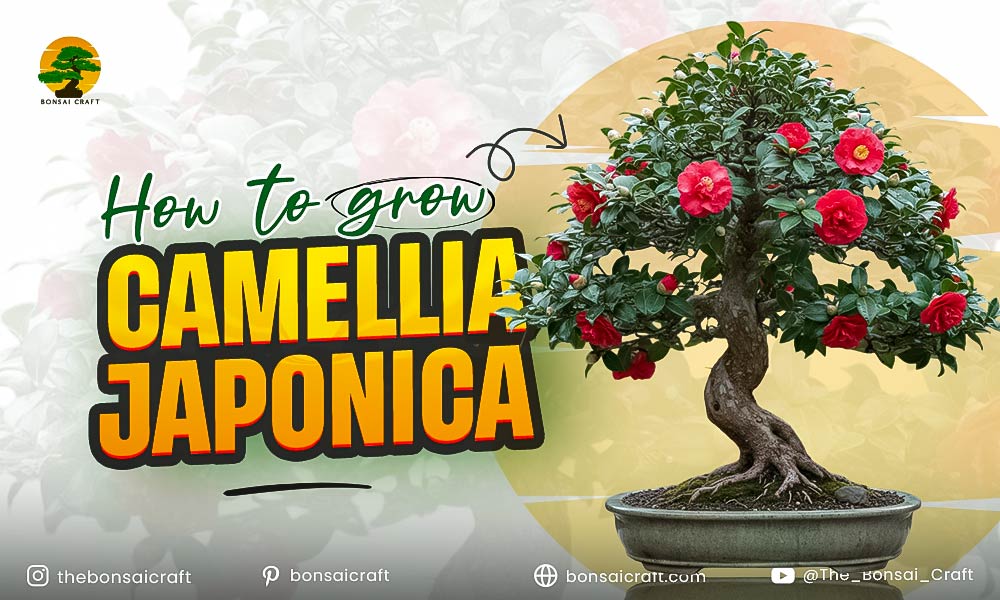
Camellia japonica, a timeless ornamental shrub, is adored for its glossy leaves, elegant growth habit, and stunning blooms. Whether you’re cultivating a japonica camellia in your garden or experimenting with container growth, knowing how to grow camellia japonica correctly can make all the difference. This guide draws from expert horticultural experience, scientific sources, and practical insights to give you a comprehensive roadmap for nurturing your Camellia japonica plant, boosting flowering, and maintaining long-term plant health.
From camellia japonica care basics to propagation, flowering, and troubleshooting common problems, this article provides actionable tips for enthusiasts at every level. Let’s dive in.
What Is Camellia Japonica?
Camellia japonica is an evergreen flowering shrub native to East Asia, primarily Japan, prized for its glossy dark green leaves and vibrant flowers. It can grow as a camellia japonica tree or a garden shrub, with varieties ranging from dwarf to large forms, perfect for ornamental displays.
The genus Camellia contains over 100 species, but Camellia japonica is the most widely cultivated. It is valued for its ability to thrive in temperate gardens while producing large, showy flowers in shades of red, pink, and white. Japonica camellia is slow-growing but long-lived, often flourishing for decades with proper care. The plant’s thick, glossy leaves provide an attractive backdrop for blooms and make it suitable for hedges, bonsai, or container gardening.
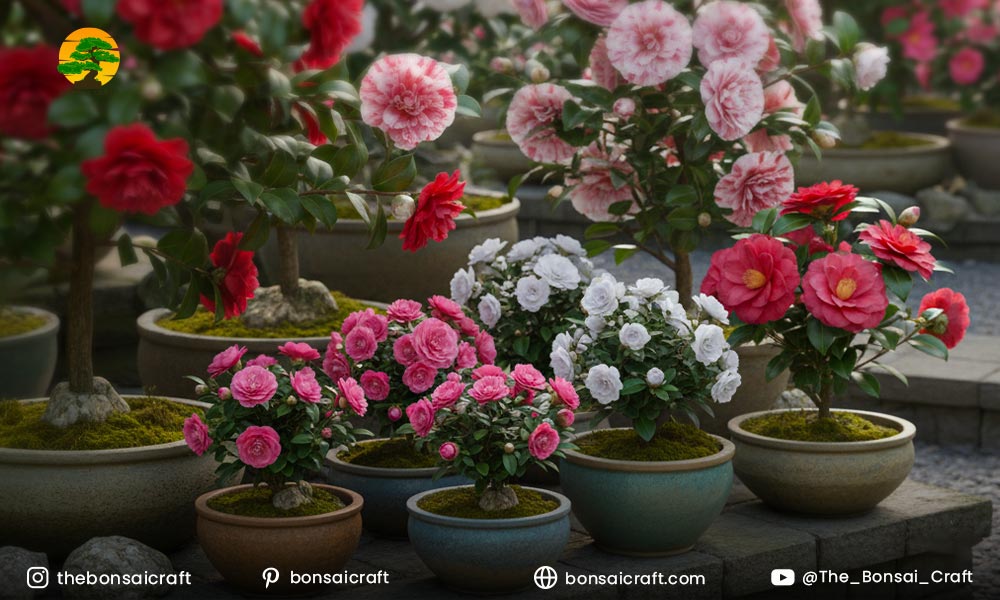
Explore popular Camellia japonica varieties to choose the perfect blooms for your garden.
Camellia Japonica Varieties
There are numerous camellia japonica varieties, including red camellia japonica, dwarf camellia japonica, and multi-colored hybrids. Each variety differs in flower form, size, and growth habit, allowing gardeners to select plants suitable for full gardens, terraces, or indoor containers.
Detailed Explanation:
- Red Camellia Japonica: Bold red blooms, ideal for visual impact in landscapes.
- Dwarf Camellia Japonica: Compact form, perfect for pots and small garden spaces.
- Single vs Double Flowering Varieties: Single blooms have a classic cup shape, while double flowers offer fuller petals and a more dramatic aesthetic.
Selecting the right camellia japonica varieties ensures optimal flowering and growth, tailored to your local climate and garden space.
Ideal Growing Conditions for Camellia Japonica
Light & Placement
Camellia japonica prefers partial shade, with morning sun and afternoon protection. Avoid harsh midday light to prevent leaf scorch, especially for young plants or japonica camellia japonica grown in containers.
- Best planted where it receives 4–6 hours of indirect sunlight.
- It can be grown under tall trees or on a shaded patio.
- Container-grown plants benefit from rotating pots for even light exposure.
Temperature & Humidity
- Prefers temperate climates, USDA zones 7–9.
- Frost-sensitive; protect from cold winds and temperatures below 10°C (50°F).
- High humidity encourages healthy leaf and flower development.
Soil Requirements
- Requires acidic, well-draining soil (pH 5.5–6.5).
- Rich in organic matter and mulch to retain moisture.
- Avoid heavy clay soils; amend with compost, peat, or pine bark.
Internal Link Suggestion: Read more about Choosing the Right Soil Mix for Acid-Loving Plants.
Planting Camellia Japonica
To plant camellia japonica, dig a hole twice the size of the root ball, set the plant slightly above ground level, and backfill with a mix of native soil and organic matter. Water thoroughly and mulch to conserve moisture.
Detailed Explanation:
- Garden planting: Space shrubs 3–5 feet apart for adequate airflow.
- Container planting: Use a slightly acidic potting mix and ensure drainage holes.
- Water immediately after planting and maintain consistent moisture for the first few weeks.
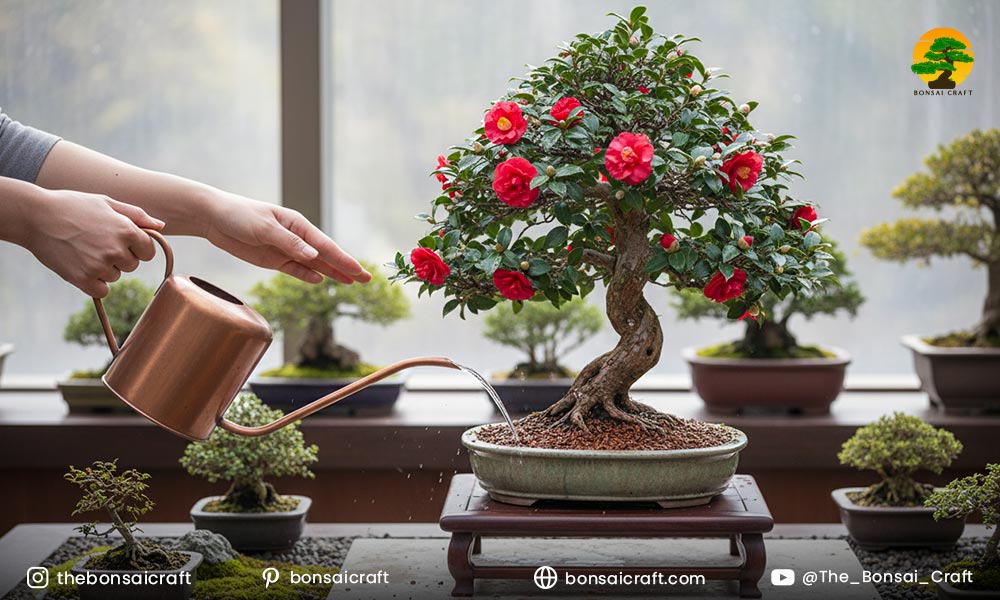
Master watering and moisture management to keep your Camellia japonica healthy and thriving.
Watering & Moisture Management
Camellia japonica needs consistent moisture without waterlogging. Water deeply during dry spells and reduce frequency in winter. Mulching helps retain soil moisture and regulate temperature.
Detailed Explanation:
- Water when the top 2–3 inches of soil are dry.
- Overwatering can cause root rot, while underwatering leads to leaf drop.
- Consider drip irrigation or slow-release watering for large garden beds.
Fertilizing Camellia Japonica
When to Fertilize Camellia Japonica
Fertilize camellia japonica in early spring before flowering and after blooms fade using a slow-release, acid-based fertilizer. Avoid high nitrogen in late season to prevent leaf overgrowth at the expense of flowers.
Detailed Explanation:
- Use camellia-specific fertilizers with balanced N-P-K ratios.
- Indoor or container plants: apply liquid fertilizer every 4–6 weeks.
- Mulch with organic matter to improve soil fertility naturally.
Pruning & Maintenance
When to Prune Camellia Japonica
Prune camellia japonica immediately after flowering to shape the plant and remove dead or crossing branches. Avoid late-season pruning to prevent frost damage to new growth.
Detailed Explanation:
- Structural pruning for shape, thinning for light penetration, and deadheading spent flowers.
- For dwarf varieties, pinch back new growth to encourage bushiness.
- Wiring and training are optional for formal garden designs or bonsai.
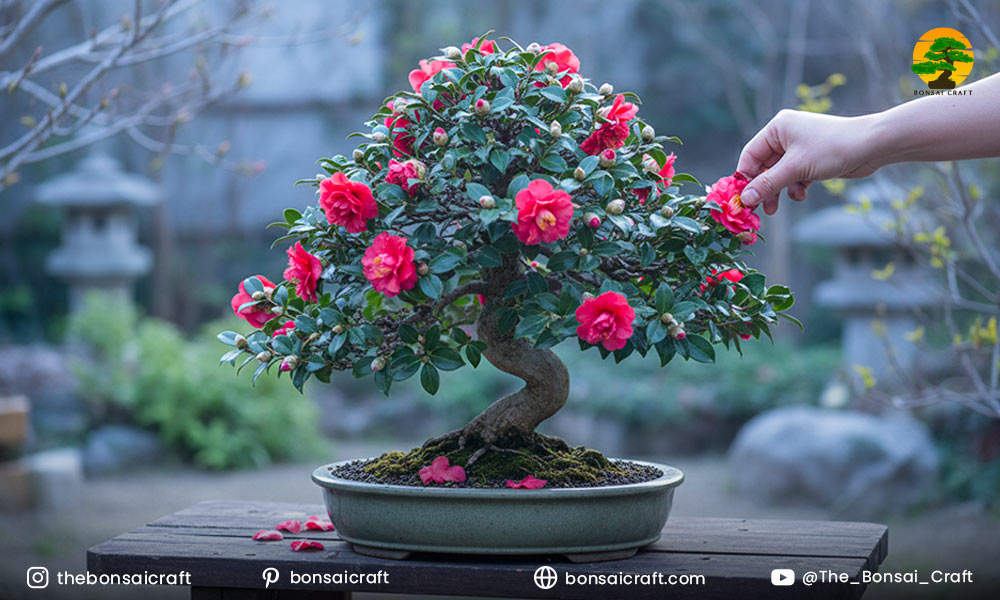
Learn essential tips for flowering and bloom care to enjoy stunning Camellia japonica blossoms.
Flowering & Bloom Care
When Does Camellia Japonica Bloom?
Camellia japonica blooms in late winter to early spring, with peak flowering influenced by variety, light exposure, and care. Proper soil, moisture, and fertilization enhance bud formation.
Detailed Explanation:
- Flower buds form in autumn; frost or drought can reduce blooms.
- Protect buds from direct sun and cold winds.
- Deadhead faded blooms to redirect energy to new growth.
Propagation Methods
Camellia japonica can be propagated through semi-hardwood cuttings, grafting, or air layering. Seed propagation is slower and produces variable results.
Detailed Explanation:
- Semi-hardwood cuttings taken in late spring root faster under mist or humidity.
- Grafting ensures exact variety traits and faster flowering.
- Seed-grown plants may take years to bloom and vary in appearance.
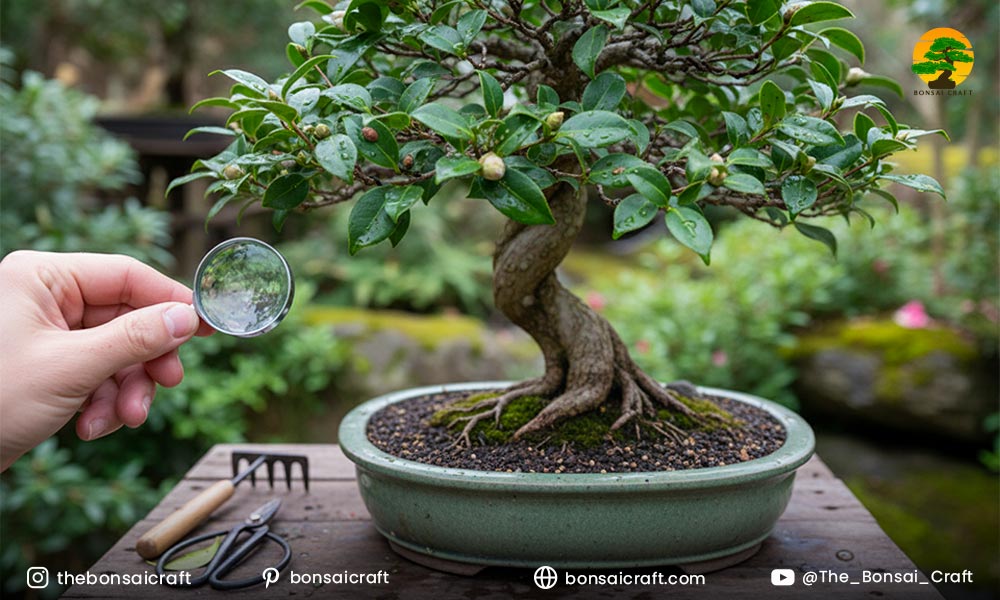
Identify and manage common pests and diseases to protect your Camellia japonica plants.
Common Pests & Diseases
Pests like aphids, scale, and spider mites, along with fungal diseases such as leaf blight, can affect camellia japonica. Early detection and proper care maintain plant health.
Table of Common Issues:
|
Problem |
Likely Cause |
Solution |
| Aphids/Scale | Dense foliage | Prune canopy, insecticidal soap |
| Spider mites | Dry conditions | Increase humidity, apply horticultural oil |
| Leaf blight/fungal | Poor airflow, wet leaves | Improve ventilation, fungicide spray |
| Yellow leaves | Nutrient deficiency | Fertilize with acid-loving plant fertilizer |
Camellia Japonica vs Camellia Sasanqua
Camellia japonica has larger flowers and blooms in late winter to early spring, while Camellia sasanqua flowers in fall and tolerates more sun. Both are evergreen but differ in size, leaf shape, and growth habit.
Detailed Explanation:
- Japonica: bigger, showy blooms, prefers partial shade.
- Sasanqua: smaller blooms, sun-tolerant, and faster-growing.
- Choose based on garden exposure and desired bloom season.
Benefits of Growing Camellia Japonica
Camellia japonica benefits include stunning ornamental flowers, glossy evergreen leaves, and support by attracting pollinators. Dwarf varieties allow container gardening for small spaces.
Detailed Explanation:
- Enhances aesthetic appeal in landscapes and patios.
- Supports bees and beneficial insects during bloom.
- Long-lived, with low maintenance once established.
Tips for Growing Healthy Camellia Japonica
- Maintain acidic soil and consistent moisture.
- Provide partial shade and avoid harsh sun.
- Fertilize during growth season and prune after blooming.
- Monitor for pests and treat early.
- Choose varieties suited to your climate and garden space.
Internal Link Suggestion: Read more about Growing Acid-Loving Plants for Your Garden.
Conclusion
Growing camellia japonica successfully combines proper horticultural knowledge with hands-on care. From choosing the right variety and planting location to watering, fertilizing, and pruning, every step contributes to healthy foliage and beautiful blooms. By following these expert guidelines, your japonica camellia will thrive, bringing vibrant color and elegance to your garden or container display for years.
Share your Camellia japonica photos or gardening tips in the comments below and join our community of plant enthusiasts!
FAQs
When does Camellia Japonica bloom?
Camellia japonica typically blooms in late winter to early spring. The exact timing depends on the variety, local climate, and plant health. Proper soil, sunlight, and moisture help ensure abundant flowering.
How do I fertilize Camellia Japonica?
Fertilize camellia japonica in early spring before flowers bloom and after flowering. Use slow-release acid-based fertilizer or liquid feed every 4–6 weeks for container plants to support healthy growth and vibrant blooms.
Can Camellia Japonica grow in containers?
Yes, Camellia japonica adapts well to containers, especially dwarf varieties. Use acidic, well-draining soil, ensure adequate sunlight, and maintain consistent moisture for healthy container growth.
How do I protect Camellia Japonica from pests?
Inspect leaves regularly for aphids, scale, or spider mites. Improve airflow, prune dense areas, and apply horticultural oils or insecticidal soap as needed to prevent infestations.
What is the difference between Camellia Japonica and Camellia Sasanqua?
Camellia japonica has larger blooms and flowers in late winter-spring, preferring partial shade. Camellia sasanqua blooms in fall, tolerates more sun, and grows faster, with smaller flowers and thinner leaves.
